Last updated on October 28, 2022

Introduction to Prophecy | Illustration by Micah Epstein
Hello everyone and welcome to the wizarding world of Strixhaven! In a land where the students want to do nothing more than to learn, you’ll find fierce rivalries between some houses and close alliances between others.
The new mechanics in this set make it more unique than most in recent memory, so we need to understand how these affect the format before we jump into what it looks like!
Strixhaven Mechanics
There aren’t many cards with ward in the set, but magecraft and the learn/lesson combination is a very large part of this limited format. We’ll see much more about why these are so relevant and what impact they play on the format when we dive into archetypes a bit further down.
Magecraft
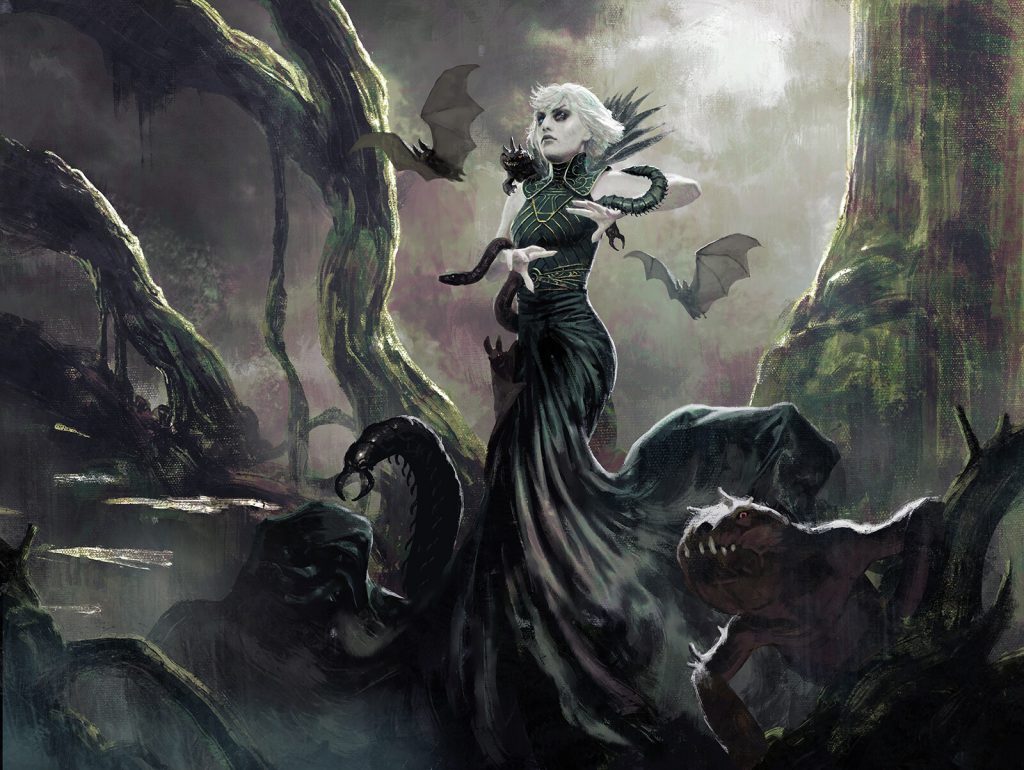
Sedgemoor Witch | Illustration by Igor Kieryluk
This is a bonus that’s added on to a permanent that rewards a player when they cast or copy an instant or sorcery. These effects range from gaining life to giving a creature +1/+0 to drawing a card. While it would be tough to stomach playing a card that will likely only trigger twice in most formats, Strixhaven is unique.
Many decks will actually end up with more instants and sorceries than creatures. Even when decks don’t have more spells than creatures, they’ll often have some “bonus” spells which we’ll find more about with our next mechanic!
Learn/Lesson

Fractal Summoning | Illustration by Livia Prima
Learn is an interesting mechanic that seems underwhelming at face value. The card that it’s attached to is almost always worse than a card you would typically consider including in your deck. It’s highly unlikely that anyone wants to play a card that says, “Gain 4 life” or “Put a +1/+1 counter on target creature.” Tacking “draw a card” onto these all of the sudden make them playable. The thing about learn is that it’s often even better than that.
Learn gives you two options: Search your sideboard for a lesson and put it in your hand or discard a card, then draw a card. This first option is what makes learn so freaking sweet. This makes a draft so interesting since you’re drafting cards that are intended to be used as part of a “wish board.” The Strixhaven drafting experience becomes unique because, while most lessons are too underpowered to be played in your main deck, having access to a flexible suite of cards which are all essentially (and literally) sideboard cards is incredibly useful.
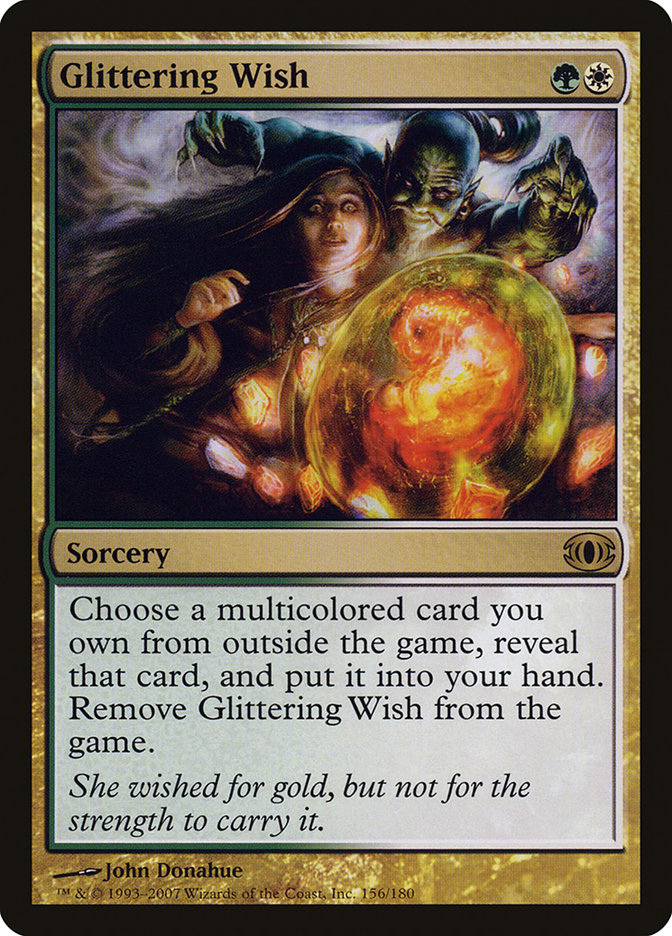
Cards like Environmental Sciences allow you to guarantee you hit your land drops with early learn cards. If you don’t need that, then you can access cards like 3-mana 3/2’s or a 5-mana removal spell that draws your opponent a card instead.
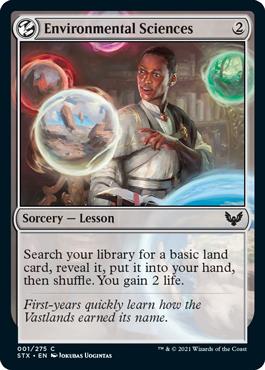
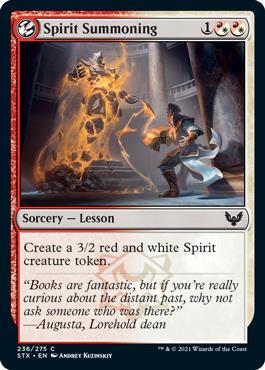
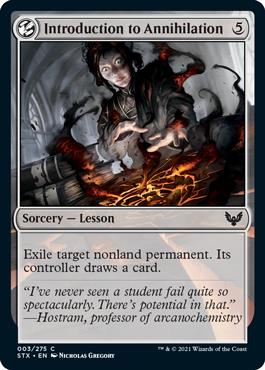
If it comes down to it and you have no lessons to learn for or they are of no use to you, you can always just discard and then draw. This mechanic will nearly always be useful over the course of the game. The learn/lesson mechanic is something that I think is great for a limited format and improves the drafting experience as well as the gameplay.
Ward

Waterfall Aerialist | Illustration by Lie Setiawan
The final new mechanic in Strixhaven is ward. This is an ability attached to a creature that makes the creature more difficult to interact with for opponents. Ward is followed by a cost that your opponent has to pay or else their spell or ability is countered. This comes in the form of an extra mana cost (e.g., Waterfall Aerialist costs two more if you want the spell to resolve) or life (e.g., if your opponent wants to target Owlin Shieldmage they need to pay three life).
Ward feels more like a simplifying of text on cards rather than an entirely new ability. This is highlighted even more so by the fact that it only appears on four cards in the set, two of which are rares.
Strixhaven Archetypes
As I jump into the archetypes, I want to note that I had varying success in the format. Some days I felt like I couldn’t build a bad deck if I tried, other days I felt like I needed to find someone at Wizards that I could bribe so that I could get at least one win.
This was very frustrating for me and hopefully everything will level out and start to make more sense as the format continues to play out and everyone better understands the strengths and weaknesses of its archetypes. Keep in mind that each archetype can go a different way than the “designed” direction of the deck.
Tier 1
I believe the following three archetypes to be the tier 1 decks of the format and the ones that I’m happiest to land in. There’s an interesting thing about a format that shoots for five viable archetypes though: cards don’t tend to overlap too often. This means that people tend to stay in their lane and it’s pretty tough to get out. With five color pairs to draft instead of the usual ten, the breakdown often goes like this: decks 1-3 have two drafters each and decks 4 and 5 each have one drafter. Can you guess which decks I want you to be in?
Don’t worry, I can feel you rolling your eyes at me. But seriously, try your best to stay open. Max_Mick, who has been absolutely crushing this format, said that he didn’t want to lock into an archetype until about halfway through pack 2. What happens while drafting is that there will often just not be anyone playing a certain color pair. This starts to become very obvious when you get something like a pack 1 pick 11 Expressive Iteration.
If you’re already locked into your archetype at this point, you’re likely going to send it right along. But if you’ve stayed flexible with your early picks and started to notice that Izzet might be open, you can jump on this and see if your theory was right. If it isn’t and it was just an odd outlier, then you can carry on finding the right archetype. If it is and you’re the only drafter playing Izzet, then you get hugely rewarded with a deck that’s likely going to be no worse than a B, even though you’re drafting it on essentially two packs.
Prismari (Izzet)
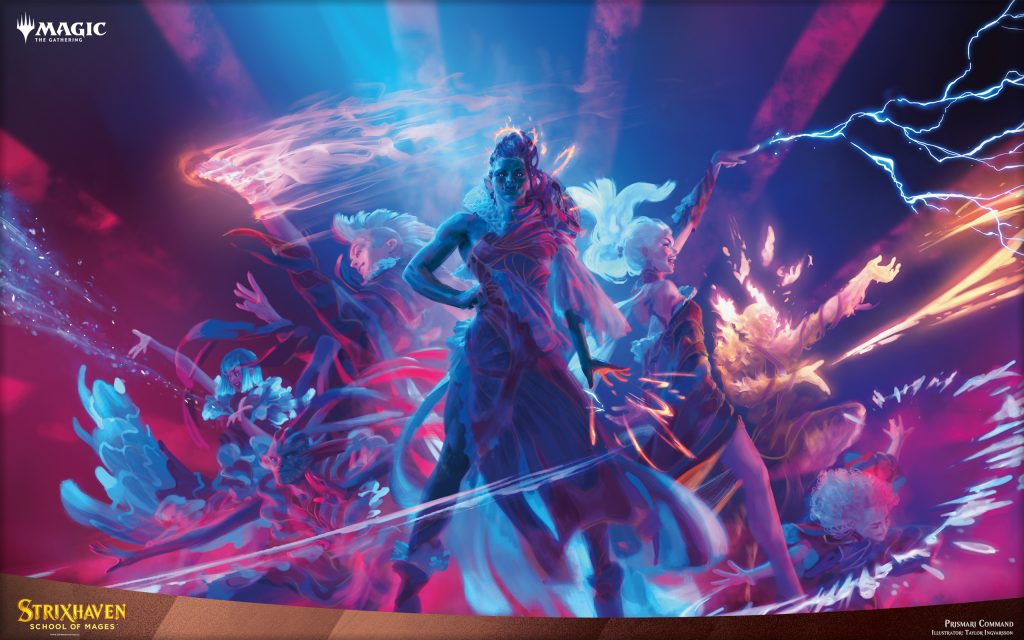
Prismari Command | Illustration by Johannes Voss
The theme of Prismari is casting expensive spells. We’ve also got a sub-theme of copying spells. The theme of casting expensive spells seems odd. In most formats, there are a handful of decks that will run you over when your plan is to cast cards that cost seven mana. This isn’t the case in Strixhaven, and Prismari gets to reap the rewards.
This is an archetype that has access to good removal, very impactful and expensive spells, and something very unique to Izzet… ramp! Spectacle Mage is what might be considered the “signpost common” for this archetype, but the uncommon that really puts in the heavy lifting is Maelstrom Muse.
The reason these cards are so important is Elemental Masterpiece. If your opponent had a fast start, this card will likely stop them in their tracks. If they had a slow start, this will likely run them over in short order, especially when backed up by other powerful uncommons like Creative Outburst and Explosive Welcome.
While “expensive spells” tend to be the theme, copying spells is a subtheme that ends up more impressive than we’d usually think. This archetype will often play as few creatures as possible and have their win-conditions be the aforementioned Elemental Masterpiece or spells like Serpentine Curve which will often make a giant creature.
While we’ve seen cards like Serpentine Curve in the past, it’s never been such a consistently large creature. Games are quickly closed when you do something like cast a Serpentine Curve with seven instants/sorceries in the graveyard and then copy it with Rootha, Mercurial Artist. Turns out two 8/8’s for six mana is pretty strong! While Rootha is the premium card that you want to be using to copy spells, Teach by Example is a perfectly serviceable card in a format dominated by instants and sorceries.
Decklist

This deck by KindRewinder is a perfect example of what most Prismari decks should look like. It has good removal to stop any sort of early aggression from opponents. Then it supplements this with a solid wish board with five different options to learn for. It finishes by capping the deck off with three Serpentine Curves and an Elemental Masterpiece to close games out.
Quandrix (Simic)
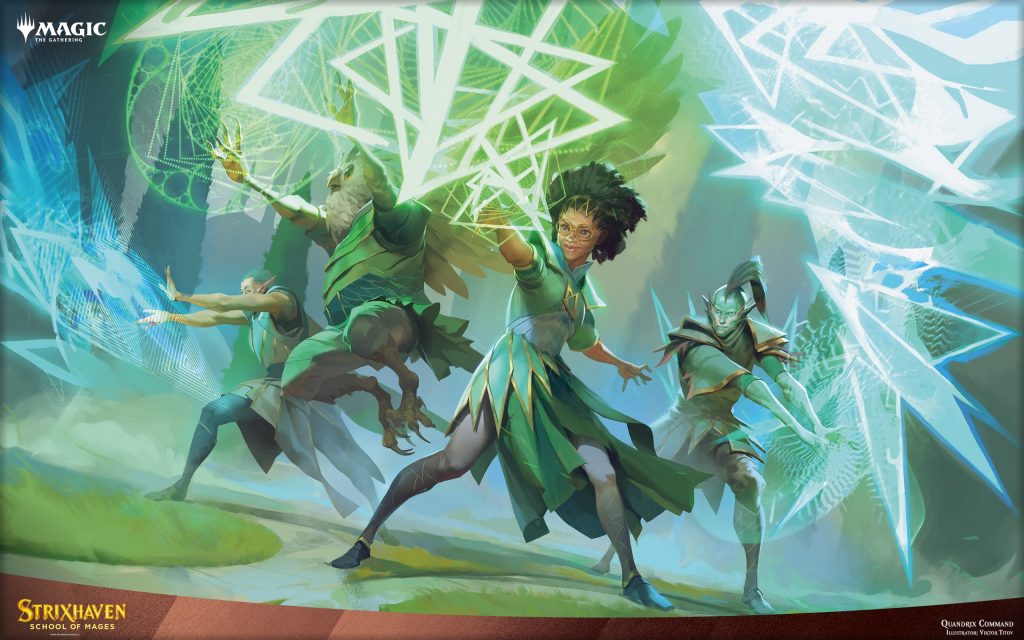
Quandrix Command | Illustration by Viktor Titov
The theme that Wizards tried to go with in Quandrix was “eight or more lands.” This seems like an odd one, and we would consider this somewhat of a pipedream in most limited formats. Fortunately for Strixhaven, it’s not too difficult to attain!
Between Field Trip, Emergent Sequence, and Quandrix Cultivator, there are plenty of ways to quickly advance your mana. The nice part about the “lots of lands matter” plan is that the cards that benefit from plenty of lands are perfectly fine by themselves. A 6-mana 6/6 is decent (Leyline Invocation) but a 6-mana 10/10 will really end a game quickly. A 2-mana 2/2 with reach is serviceable, but it’ll really shine when it becomes a 2-mana 4/4 reach.
This archetype also has solid removal that keeps creatures from staying on the battlefield in Divide By Zero, Mage Duel, and Bury in Books. It pairs this with large creatures and card draw to form a deck that’s tough to take down early and even tougher to grind out.
This archetype is typically spell-heavy with the creatures coming in the forms of spells like the aforementioned Leyline Invocation. The signpost common Quandrix Pledgemage also signals a similar trend in that it benefits from casting instants and sorceries.
Decklist
Here’s an example of a trophy winning deck from Koszmosz_123:

This deck does a very nice job of ramping early and then getting a big creature out quickly. It’s then able to buffer its life total with Witherbloom Pledgemage while it builds a board and gains card advantage. This deck can then turn the corner with either a huge Quandrix Pledgemage or Leyline Invocation.
These Quandrix decks can be a little soft against decks that are aggressive early and back it up with cheap removal. Fortunately, not many of these types of deck are out there because the format doesn’t support too many of these aggressive decks per draft pod.
Overall, I believe Quandrix to be one of the stronger color pairs in the format but this next one seems to be public enemy number 1 in the format right now.
Temur Ramp

Body of Research | Illustration by Antonio José Manzanedo
Brace yourself for this.
Take the two best decks in the format. Look at the common theme. Find that there’s a common color between the two. Realize that fixing is pretty great in this format. Jam it all together. Voila!
Temur Ramp essentially takes the best of both worlds with these two decks and sticks them together. Green gets you good ramp. Red gets you solid removal. Blue gets you card advantage and decent removal. But most importantly? These “schools” overlap!
This last point is so important because it isn’t very easy to play something like black in an Izzet deck with the five different schools in the format. Sure, you can splash a bomb with the fixing, but we’ll get to that later. If you’re going to play a color pair, the cards you’re going to want to splash will generally be in a “sister school” of sorts: one of the schools that shares a color with the one that you’re in.
This is partially because you’ll share the campus lands with them, but also because, if you’re playing Prismari for instance, there isn’t a black card in the whole set that shares a color with anything in your deck. Instead, you get access to cards like Quandrix Cultivator and Quandrix Apprentice when you add green to the mix.
Decklist
Here’s another example of a deck from KindRewinder. It uses a nice Simic base and then includes red for powerful removal and top end spells. Note that Environmental Sciences allows the deck to play one Mountain but has three ways to learn for it and an Emergent Sequence to fetch it as well.

While decks like this are incredibly powerful, you have to be wary about trying to just jump right into it. In Kaldheim, you could often force snow and have a serviceable deck. In this format, if there are two others in the pod that are trying to draft the same deck as you, you will get very cut and end up with an unimpressive deck. The worst part about it is that you’ll see the open deck going by incredibly late and suffer some serious FOMO.
Tier 2
These archetypes fall into the category of “happy to be here if available” for me. They definitely tend to have a higher fail rate than the tier 1 decks but can still be a serious threat when they come together.
Silverquill Aggro (Orzhov)

Silverquill Command | Illustration by Bryan Sola
Silverquill is what I consider the best aggressive archetype in the format. It has a good number of evasive creatures, good removal, and the learn cards play very well here. It does have somewhat of a weird theme though, which is a mix between +1/+1 counters and interaction. There are a couple creatures that have triggers when they die that have something to do with +1/+1 counters, an aggressive magecraft theme, loads of removal, and lifelink.
While all these themes tend to send mixed messages (do I really want to play a 4-drop that passes on its counters when it dies in a deck that’s supposed to be applying pressure?), the decks usually play out pretty nicely. It’s the one archetype that can consistently get under the big mana decks and finish them off before they have time to develop. Unfortunately, it’s difficult to dig yourself out of the hole if you stumble and it doesn’t play well from behind.
Decklist
Here’s a recent deck from FjodorSascha that really shows off how a solid version of this deck is going to look. With multiple ways to learn, a good wish-board, early creatures, and good removal, you can put them on their back foot early. Then, a well-placed removal spell or two will finish the game off.
Magecraft cards like Silverquill Pledgemage seem mediocre because most limited players are used to having three to six instants and sorceries in their decks. Instead, this deck has closer to 13 spells. This means that you’re able to trigger the magecraft ability most turns and can often trigger it twice to give Pledgemage flying and lifelink. The deck then tops the curve off with a couple of fliers that are either difficult to interact with or have some sort of additional value.

While I think Silverquill is a solid deck, it’s a step below the others because it essentially can’t stumble. If you don’t have a 2-drop or aren’t able to trigger magecraft, you’ll get too far behind the big mana decks. Since their cards are often just raw power, Silverquill won’t be able to keep up if the board is looking fairly even by turn 5 or 6.
Multicolor Good Stuff

Crackle with Power | Illustration by Micah Epstein
So far I haven’t mentioned a single rare in this set and that was intentional. I did this so I could finally get to this point and say that the rares in this set are busted. There are many cards that will win the game out of nowhere like Mizzix's Mastery, Crackle with Power, and Tempted by the Oriq.
The odd thing about this format is that there are cards like Exponential Growth, where your opponent can be so far ahead but you can easily upgrade a creature’s power by doubling it three or four times and stealing a game if you have an opening. I had a friend lose a match where he was at 24 life and Waterfall Aerialist was the only creature on the other side of the board. Opponent cast Exponential Growth for X=3 and the game was over!
Decklist
This deck looks to take advantage of all these incredibly powerful cards while having the ability to fix its mana with any card that has learn and an Environmental Sciences in the board. This is exactly what Max_Mick does in the following deck.

Max has an Orzhov base here with strong ways to learn like Professor of Symbology. He then dips into blue and red to get access to game-breaking cards in Lorehold Command, Magma Opus, Venerable Warsinger, and even Rootha, Mercurial Artist!
While decks like this will come together on occasion, Environmental Sciences is its lynchpin and is being picked earlier and earlier. Add this to the fact that everyone else wants to (and can) splash powerful rares, and you aren’t likely to find yourself in this deck too often.
The point of all of this is that when you see powerful cards going around the table, take them! While these bombs might not be going late, they’re still often getting passed early and they can often add serious win percentage to your deck with a little fixing.
Tier 3
This next tier is archetypes that I don’t want to be in. I think you essentially have to be the only person in the pod in these two decks and you have a chance to have a winning deck when that happens. I’m not saying that these archetypes can’t win, just that their plans are so difficult to pull together that it still isn’t terribly easy to win even when you have a nice version of the archetype.
Witherbloom (Golgari)

Witherbloom Command | Illustration by Dmitry Burmak
Witherbloom is based around the theme of gaining life. Its signpost common Blood Researcher shows that off by trying to become huge through multiple instances of lifegain. Witherbloom Apprentice and Witherbloom Pledgemage try to help accomplish this by gaining life each time an instant or sorcery is cast, but Blood Researcher is just so dang fragile.
The big problem with this archetype is that it always feels like you’re trying to assemble a combo and then some. Step 1, get down both combo pieces. Step 2, cast a bunch of instants and sorceries. Step 3, pray that both pieces survive so that you can reap the benefits of….making a big creature?
Prismari and Quandrix don’t care about all these crazy steps. They just make the big creature. Witherbloom feels especially silly when you go through a ton of work to turn your Blood Researcher into something like an 8/8 just to get it bounced back into your deck with a Bury in Books or back to your hand with Divide By Zero. At this point, that Blood Researcher is essentially just a 3-mana 2/2 with menace and slight upside since it’s likely not getting back to being anywhere close to that power level.
Decklist
The deck below is one that I snagged early on in the format. With five cards that represent repeatable lifegain and five cards that benefit from gaining life, it actually turned out pretty powerful. This was also played before everyone realized that Bury in Books is a top common. This fact has just made Blood Researcher feel kind of miserable. That being said, I still wouldn’t be happy playing Witherbloom without a handful of Blood Researchers because it’s one of the few cards that’s capable of applying heavy pressure to opponents.

Overall, I don’t think you should be intentionally passing a wide open Witherbloom deck. What I do firmly believe is that this archetype is inherently less powerful than those before, and that you want to be the only person in this lane or have some very powerful rares if you wanna make it work.
Lorehold (Boros)

Lorehold Command | Illustration by Jason Rainville
Lorehold is an archetype that has a bit of an identity crisis. It was designed with a theme of gaining value from the graveyard, as shown by the signpost uncommon Quintorius, Field Historian and a handful of commons. While Quintorius is powerful and can end a game if it sticks around, it has a fragile body that’s removed with nearly every piece of common removal in the set.
Then, if it actually does stick around, you need a way to get cards out of your graveyard. Quintorius is the perfect example of the entire theme not working out properly. The cards that come out of the graveyard usually amount to creating a 3/2 for five mana or something that’s somewhat equivalent. When you’re running into decks that are spending five mana to make two 4/4’s, your 3/2 starts looking pretty silly.
The other Lorehold archetype is likely where you want to be, and this is Lorehold aggro. Since you don’t want to out-grind the blue decks, this means you need to get under them. While this wasn’t how the deck was intended to be built, it can be an effective route. Most of the 2-power 2-drops are able to get in for a bit of damage before the go-big decks are able to build a board. Then, between Lorehold Pledgemage and Silverquill Pledgemage, you have strong 3-drops that are able to apply constant pressure.
Decklist

This is how I want my Lorehold decks to look. Literal Lightning Bolt (crazy, right?! A handful of 2-drop creatures. 3-drops that ensure we’re applying pressure. Then finish it off with some removal and fliers. While I’d have probably built this deck differently if it were today (this was day one of the format), I think that these kinds of decks just end up having a tough time winning due to a lack of card advantage and a difficult time getting on board early.
Lessons Learned in Strixhaven
Drafting and playing Strixhaven is vastly different from any other set I have drafted. Let’s break down some of the larger differences.
Learn/Lesson
This interaction is so powerful that cards that say “lesson” in their card type are essentially the best in the set. While that might a stretch, if Environmental Sciences wasn’t a lesson it would likely be a C- to D in most sets. Shoot, it would be rated that low in this set! Instead, it’s the best common in the set by what I feel is a decent margin.
The same applies to other lessons cards. This also skews the pick order of cards with learn. If a card with learn was decent without it, then it’s great. If the card was pretty bad without learn, then it’s good. If the card with learn was virtually unplayable without it, then it’s still probably mediocre. I’m looking at you Guiding Voice. Sorry First Day of Class, you don’t even make this cut.
This means that you want to pick up good lessons early and often while you’re drafting, and keep your eyes peeled for decent learn cards that would allow you to pull from a variety of sideboard cards mid-game. This will keep you more flexible while drafting, while also making a deck have more picks that impact your overall draft.
I’m not saying to take these over top tier bombs, just make sure that you’re not ignoring these flexible cards that always “make your deck.”
Bombs
Bombs in this format have a unique impact that I’m not used to. In most format you have to be wary of running into Koma, Cosmos Serpent or Starnheim Unleashed. These cards will close a game when they hit the board, usually even when the caster is far behind.
Strixhaven takes this to the next level. Here’s a quick list of cards that will flip a game right on its head:
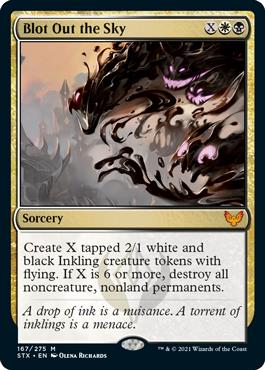

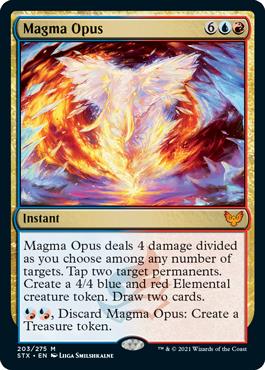
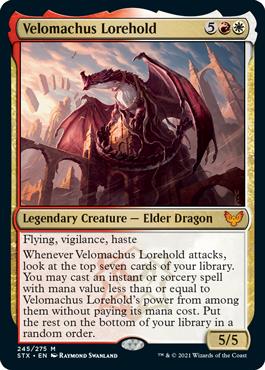


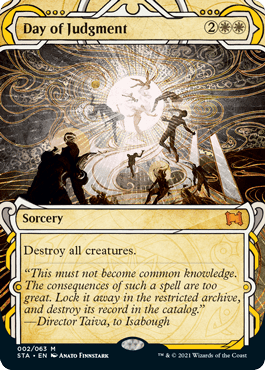
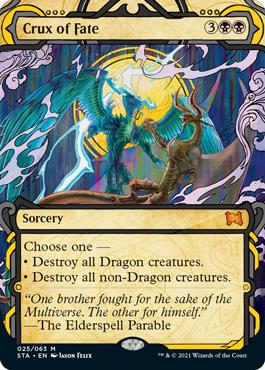
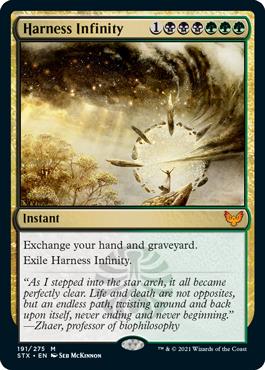

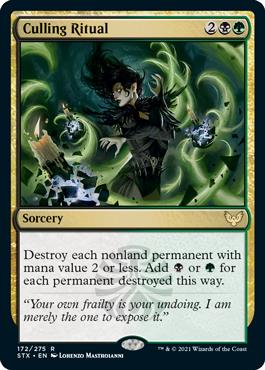
- Blot Out the Sky
- Mizzix's Mastery
- Magma Opus
- Velomachus Lorehold
- Crackle with Power
- Draconic Intervention
- Day of Judgment
- Crux of Fate
- Harness Infinity
- Exponential Growth
- Culling Ritual
What I mean by this is that these are all cards that take a game from being solidly in control for one player, to either neutral or favored for the caster of these spells. A couple just win the game on the spot. While some of these cards aren’t always great or even good (Exponential Growth and Culling Ritual are my prime suspects here), they’re still cards that need to be respected.
What this means is that gameplay is fundamentally altered. With at least 10 cards that turn a game around in a flash, you want to always be applying as much pressure as you’re capable of. In a format with one bomb that can turn the game around, I’ll tend to play safe and not be overly aggressive with my attacks. In Strixhaven, I want to swing where I can when I can because that Crackle with Power might just be one draw away waiting to deal 10 damage to me and take out one of my creatures if I don’t.
Schools
One thing that has become apparent in recent weeks is that you don’t need to be in a guild. Dimir has been a popular deck folks have been chatting about recently. I believe that it’s typically right to stay in your school or just play multicolor bomb decks. That being said, maybe once every other draft there should be a player that’s just drafting the good cards that are coming in from two unaligned colors. This would mean that once out of every 16 drafts or so you could be in a 2-color deck that isn’t a school.
When drafting a color pair that isn’t a school, you miss out on access to incredibly powerful cards like Dramatic Finale which is virtually unplayable outside of Silverquill. Choose your battles wisely and, if you never drafted a 2-color deck that isn’t supported during this entire format, that would be fine! Just be aware that it’s a possibility and one that you can capitalize on every once in a while.
Best Commons in the Set
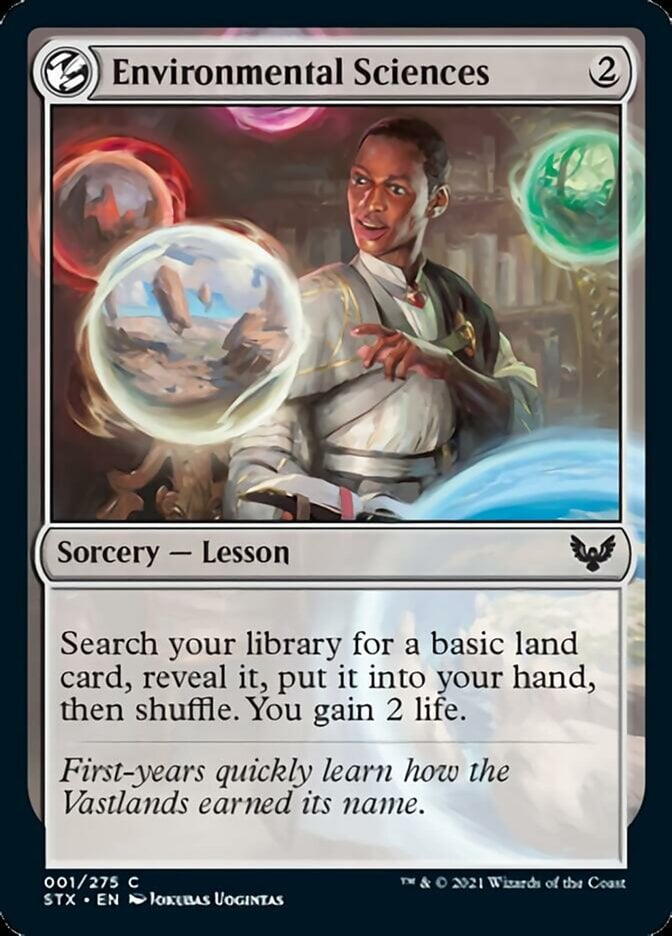
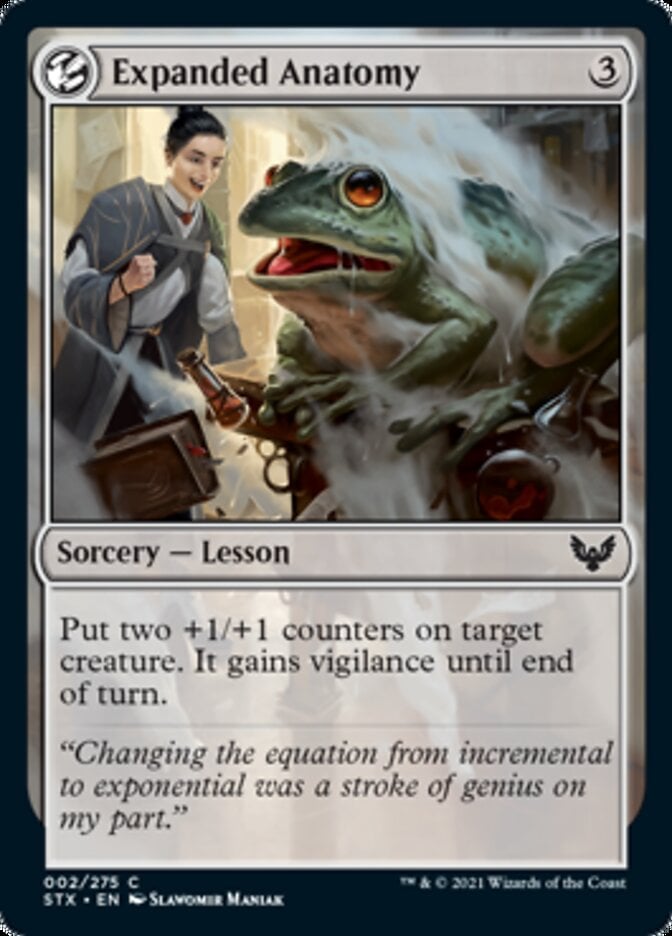


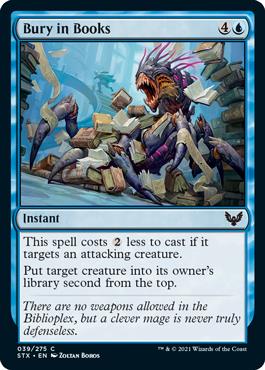

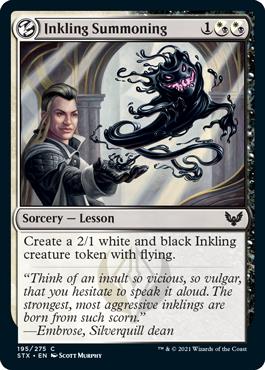

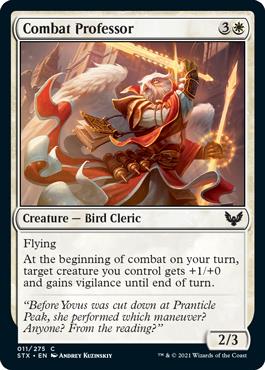

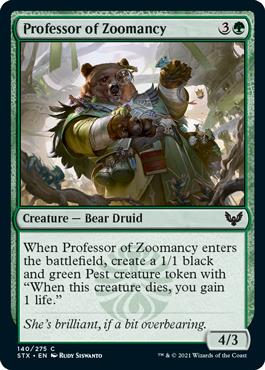
Some Other Notable Cards
Biggest Groan Test

Opponent learns for Mascot Exhibition.
“So you’re telling me there’s a chance…”
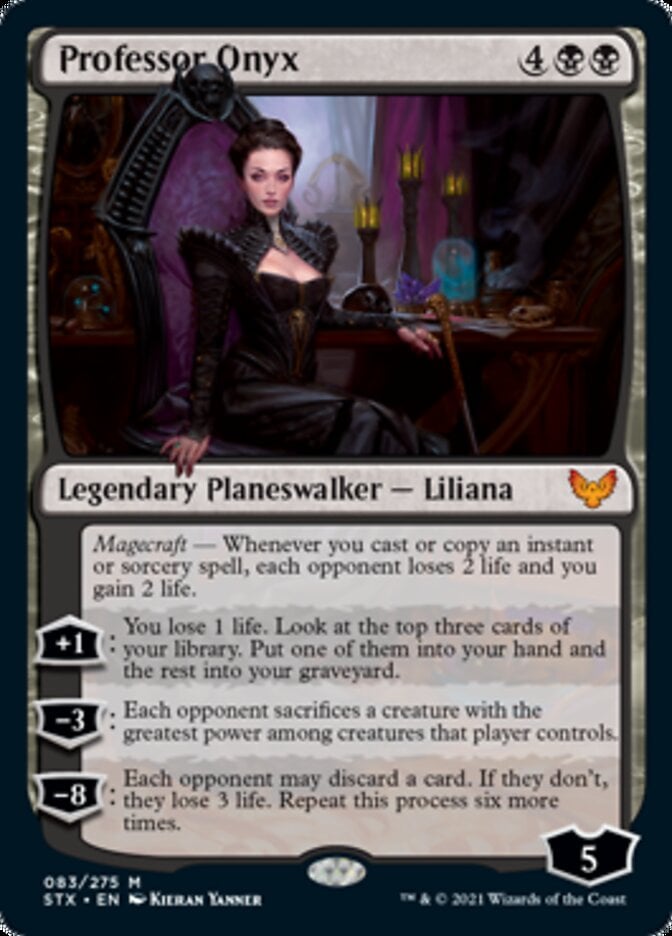
Sitting across from Professor Onyx.
And the rich get richer!
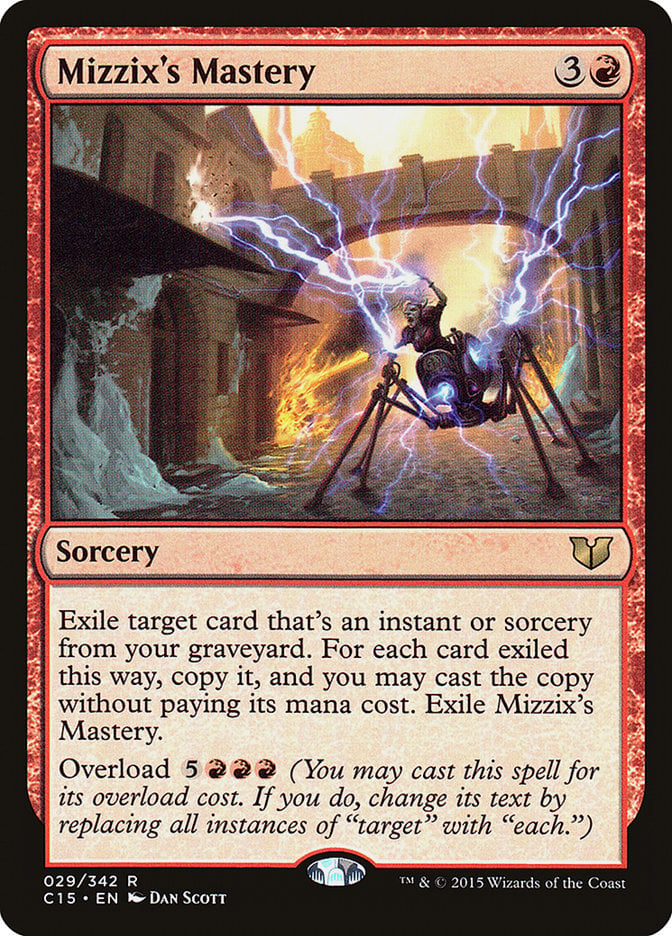 Mizzix's Mastery
Mizzix's Mastery
Did it have to be an instant?!
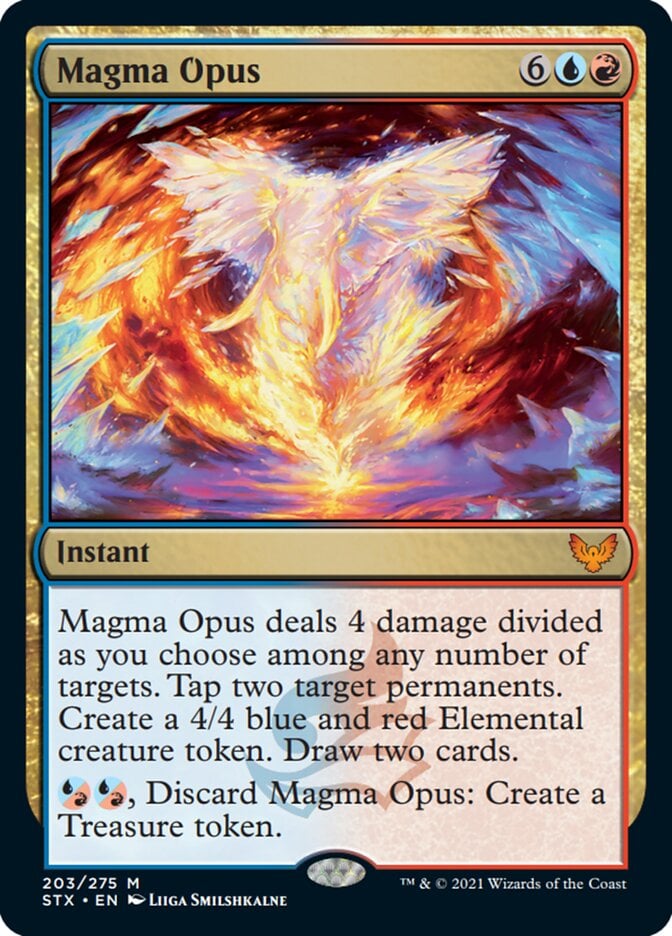 Magma Opus
Magma Opus
Wait… that isn’t an instant??
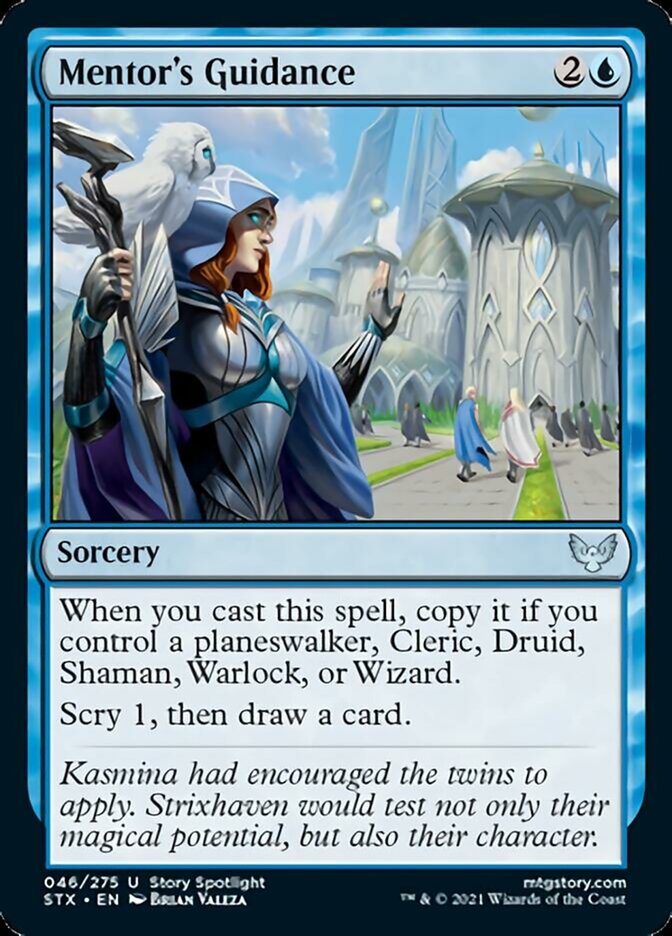 Mentor's Guidance
Mentor's Guidance
They only have one mana, what could possibly go wrong?

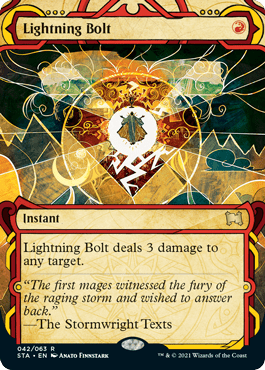
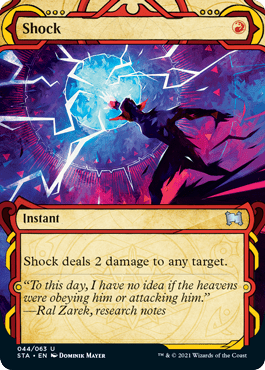
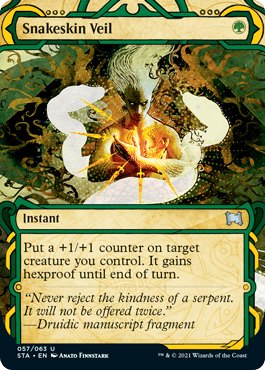
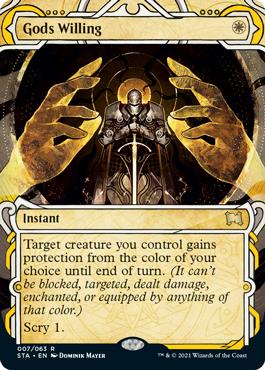

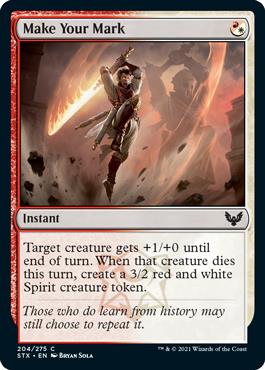


Tie between Swords to Plowshares, Lightning Bolt, Shock, Snakeskin Veil, Gods Willing, Mana Tithe, Make Your Mark, Charge Through, and Defiant Strike.
YOINK!
 Tempted by the Oriq
Tempted by the Oriq
It’s Coming!
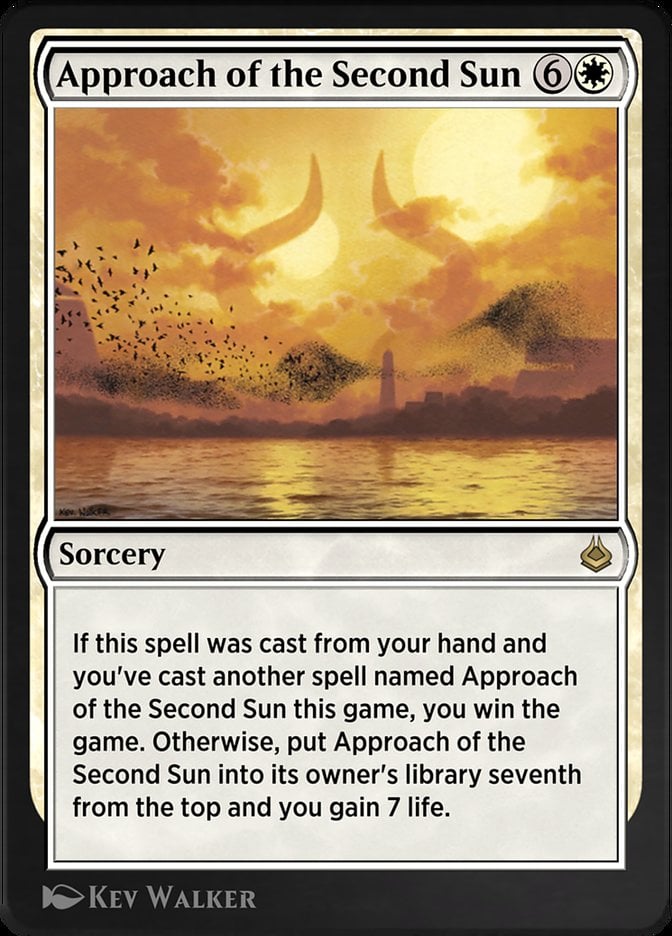 Approach of the Second Sun
Approach of the Second Sun
Wrap Up
Strixhaven has been a departure from most formats I’ve played, and it definitely changed the drafting experience. There are some things about this format that I really enjoyed while others made it a bit of a drag. I’d be glad if there was never a Mystical Archive-esque card ever printed again for drafting purposes, though the likelihood of this happening seems low.
On the other hand, I’d love to see lesson/learn in more formats because it makes each card you draft more impactful. Again, the likelihood of this happening also seems low. The campus lands were great and I’d love to see this kind of land in draft sets fairly frequently. Likelihood medium? But I also find guild sets with only half the guilds to be boring and redundant, and I’d prefer that they never happen again. Likelihood: zero.
Maybe I’ll try to not be greedy and just ask Wizards to just include all the guilds if they’re going to have guild sets. This way when you start a draft with a good black card and then see a good blue card the next pick, you can take it and have the belief that they could both make your deck!
This format is definitely going to go down as a memorable one. I really hope that these new mechanics will carry over to other sets. Overall, while it wasn’t my favorite format of all time, it’s one that Wizards made an active effort to feel unlike any other draft format, and I can appreciate those efforts.
One other tip: if you want some extra help while drafting on MTGA, be sure to check out Draftsim's app Arena Tutor. It eases your mental load by using AI to give you great draft pick recommendations, including for Strixhaven!
Good luck to everyone in their endeavors in the rest of Strixhaven and feel free to get in touch if you have any questions.
Follow Draftsim for awesome articles and set updates: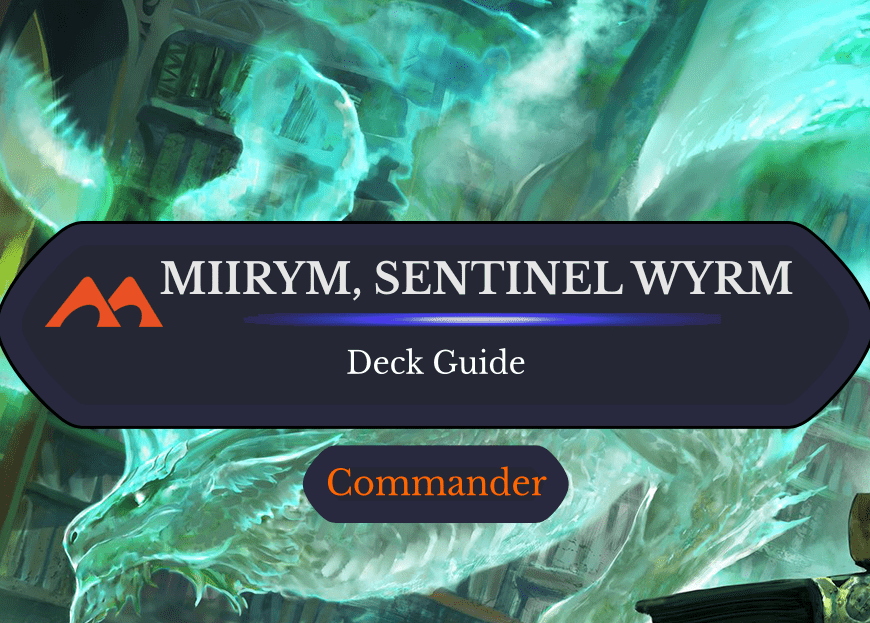
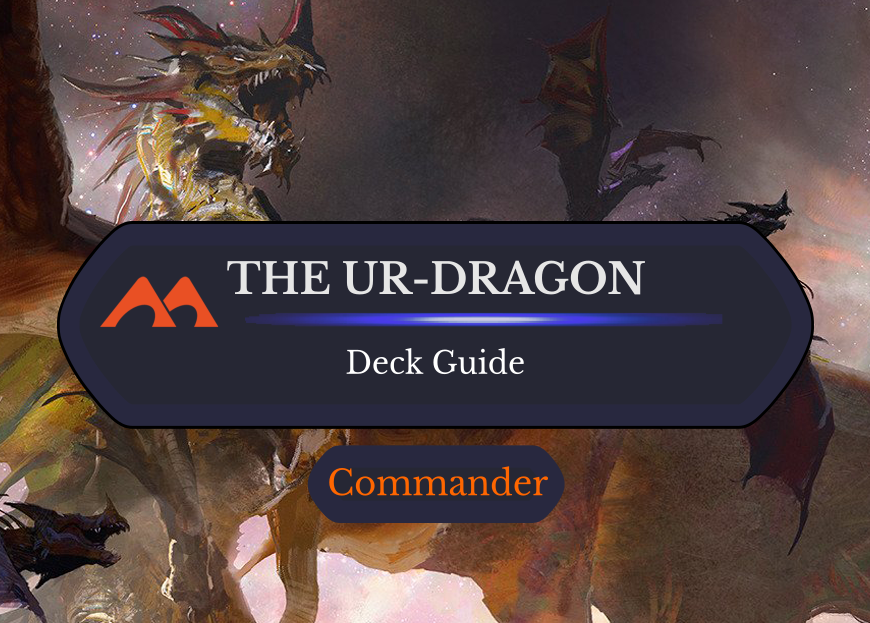
Add Comment